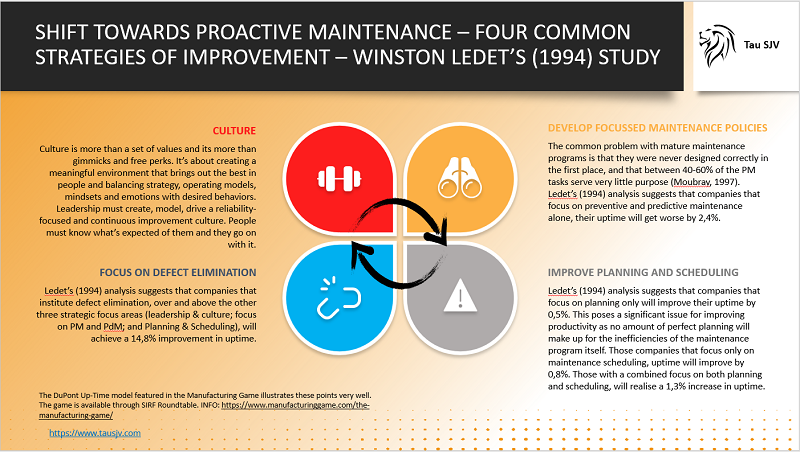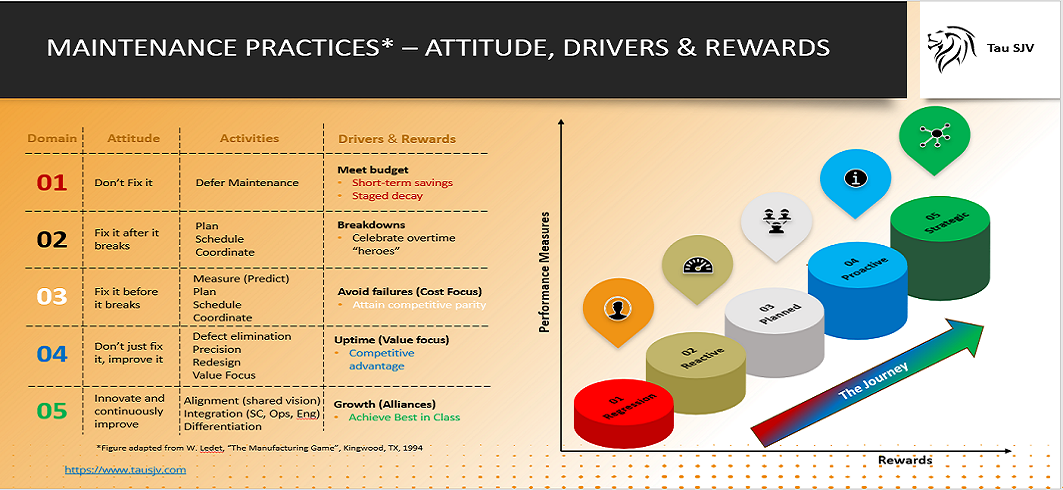INTRODUCTION
The value and benefits of pro-active maintenance and asset management for both industry and companies have been recognised and actively pursued for over 20 years. However, the burning question is: why are most companies stuck in the reactive and planned maintenance domains and not advancing toward pro-active domain to reap the benefits?
Increased competition and customer demand for timely delivery of high-quality products have forced manufactures to rethink their maintenance practices. Faced by these mounting pressures, manufacturers have made significant investments in modern production machines to drive “automation”. To achieve the targeted rates of return on investment, machines must operate reliably and be capable of being kept reliable without costly work stoppages and repairs. But, the attention that the maintenance discipline receives is often of a haphazard nature without any proper integration between the various techniques employed. The typical approach towards increasing the efficiency of the maintenance is to implement some highly publicised maintenance techniques. These include RCM, TPM, CBM, PdM, and the like. While each of these will contribute to reliable machine operation, the haphazard manner in which they are introduced can lead to sub-optimality.
The typical challenges faced by vast majority of manufacturers and asset owners, across all major industries, and why they are stuck in reactive and planned domains include, but are not limited to:
-
1) No executive leadership support - for an asset management (AM) policy, plans and strategy to be successfully implemented, executive leadership buy-in and support is non-negotiable. The drive from the top enables the middle management team to institutionalise the strategy and for the rest of the team to execute on it. Lack of an executive leadership buy-in and sponsorship will impede AM maturity progression into the lower domain (regression, reactive).
2) Lack of strategic alignment - between the business and asset management (AM) function, leading to a strategic disconnect. Strategic alignment between business’ strategy and AM strategy ensure all stakeholders share common objectives and drive towards the same goal.
3) Ineffective Work Management process - poor or low focus on the early identification, planning, scheduling, and execution of corrective work is characteristic of mediocre companies that have low resource utilisation (wrench time), increased waste of resources (materials, costs, etc.) and low compliance to scheduled work. Best performing companies get this right.
4) Inherently low reliable equipment - reliability is a design attribute and no amount of maintenance will increase a machine’s inherent reliability. You get the reliability you pay for. Machines with low inherent reliability and too frequent unplanned downtimes keeps companies stuck in the low maturity domains.
Selecting the most appropriate maintenance strategy depends on factors like the criticality of assets, available resources, budget constraints, and business objectives. Many organisations use a combination of these strategies to optimise maintenance efforts and maximise asset performance. Regularly reviewing and adjusting maintenance strategies based on performance data and changing conditions is essential for long-term success.
The decision to use RCM stems from a rigorous set of questions such as:
-
1) How does the failure occur?
2) What is the likelihood of failure?
3) What are its consequences?
4) What good can preventative maintenance do?
In 1991, Winston Ledet and his team from DuPont, studied 15 of America’s most prestigious manufacturing plants and dozens of their own plants. They found that DuPont spent 10-30% more, per $ of plant value, on maintenance compared to the industry leaders and uptime was 15% lower. Ledet continued this study over several years to include 140 more plants across Europe and Japan.
From this study, Ledet classified the maintenance behaviors of the plants into 5 domains. These domains are described in the document attached.
Realistically ask yourself - in which maintenance domain does your organisation fall under? We would like to hear your views. Helping organisations move up the ladder of maturity is an integral part of our reliability consulting service. Reach out to us at info@tausjv.com to book a meeting with us.


